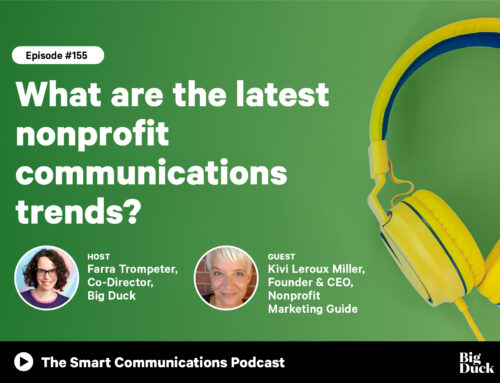The coming weeks are the busiest of the year for nonprofit communicators.
GivingTuesday will gobble up much of our attention during the first week of December. Then comes the critical end-of-year giving season.
But as you think about how to navigate the final, frantic days of 2019, a new year beckons. With it comes your chance to experiment with new strategies and approaches that will help your organization gain more attention, build stronger connections with supporters, and raise more money to support your mission.
Here are five trends I’ve been watching that are likely to impact your communications in 2020.
1. Interacting Through Facebook Messenger
Like it or not, Facebook became a much bigger force in the nonprofit world in 2019 — stepping up its investments in tools that are designed to get people to donate money to their favorite causes directly through the world’s largest social network.
Facebook this fall announced that donors have now contributed more than $2 billion to nonprofits through the platform. And earlier this month, it rolled out a number of new features, including a fundraising sticker, as well as new functionality on Instagram that aims to make it easier to collect and process donations.
The most direct result of these new features is more money. Nonprofits that have been investing in building communities and testing fundraising asks on Facebook are getting rewarded.
But it has also created what amounts to a new communications channel for charities. Some technology providers, in fact, have been rolling out tools that allows nonprofits to communicate with their Facebook donors using the platform’s Messenger direct-messaging tool.
“Since April, No Kid Hungry has been working with GoodUnited to test a new feature that allows nonprofits to ask supporters who create Facebook fundraisers permission to communicate directly with them through Facebook’s messenger tool,” writes Peer-to-Peer Professional Forum President David Hessekiel on Forbes. “To date, 13 percent of those it has contacted have opted in. And No Kid Hungry is already collecting data that shows these fundraisers raise more money than those who choose not to communicate through messenger.
“The ability to communicate directly through Facebook messenger will likely open a lot of new doors for nonprofits that want to build deeper relationships with those who host campaigns on the social network.”
I expect to see more nonprofits using Messenger in 2020 — and for communicators to play a leading role in developing messages and tools that are designed exclusively for this emerging communications channel.
2. Livestreaming Becomes Mainstream
More than 150 million people per month are using livestreaming video sites like Twitch to watch people play video games, cook, sing, or simply hang out. With numbers that large, it should come as no surprise that livestreaming is becoming an important communications and fundraising channel for nonprofits.
Early adopters like Children’s Miracle Network Hospitals have used livestreaming to fuel fundraising campaigns that raise millions annually. CMNH’s Extra Life campaign, for example, generated $13.5 million in 2018 — spawning interest among a number of other nonprofits who are looking to connect with potential donors and spokespeople.
3. The 2020 Election Dominates the News
If you think it’s been difficult to get news coverage for your nonprofit in recent years, get ready for 2020.
The Presidential election — and the drama over the possible impeachment of President Trump — promise to suck up an inordinate amount of media oxygen between now and next November.
For nonprofits, the challenge is clear. There will be fewer opportunities to generate earned-media coverage next year, particularly at the national level.
But there are some ways where you can try to stand out.
One is by focusing your earned-media outreach efforts more locally (see Thinking Smaller, below). Another is by ramping up your paid and owned media efforts for the short term and dialing back your expectations for earned media for the time being.
4. The Power of Persuasion
Sometimes, to stay ahead of the curve, it pays to zig while others are zagging.
That’s why I encourage every nonprofit I work with to consider doubling down on op-eds.
As noted above, it’s going to be tough sledding for groups that are hoping to pitch stories to journalists next year.
But there’s still plenty of room for organizations that want to pen their own stories.
In recent months, we’ve had great success helping nonprofit and foundation leaders write and place pieces in national and international outlets like the USA Today and the International Business Times, major metros like The Washington Post and the Detroit Free Press, and smaller, local outlets like The Buffalo News and New York’s Straus Newspapers.
With reporting staffs only growing smaller, many outlets are hungry for well-written, timely work.
If your organization has something important to say, this offers you some great opportunities. Consider allotting some of your media efforts around creating opinion pieces for news outlets.
5. Thinking Smaller
For national nonprofits, rather than competing with other national organizations for mind share in the national media, consider taking your message to the local level.
One way to do this is to create customized news advisories about a key issue (such as homelessness) that includes local statistics for each key market. Then, you can position a key leader from your organization as an expert voice who can help provide context and information around that topic.
If you’re a national organization with local chapters, consider providing media kits to your local offices that can give them tools to become expert sources for TV stations and newspapers in their markets.
Resolve to adopt some of these strategies to help make the most of 2020.
Let us know what 2020 holds for you by taking our 2020 Nonprofit Communications Trends Survey. Closes Tuesday, December 3rd.

![12 Things You Can Stop Doing Right Now [Infographic]](https://www.nonprofitmarketingguide.com/wp-content/uploads/2025/01/Stop-Doing-2025-Info-hung-up-500x383.png)



